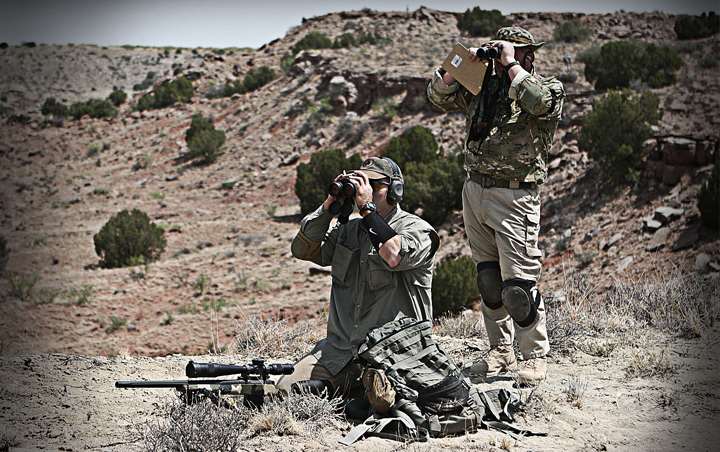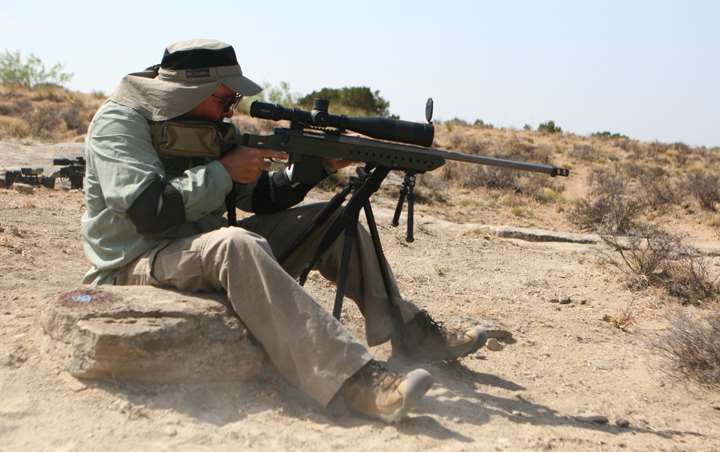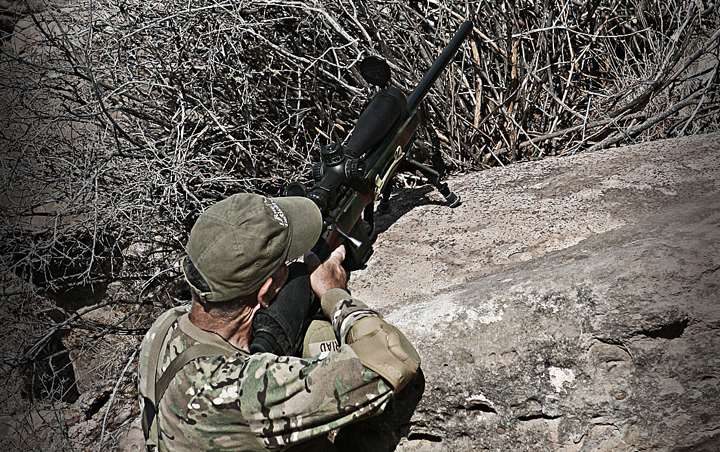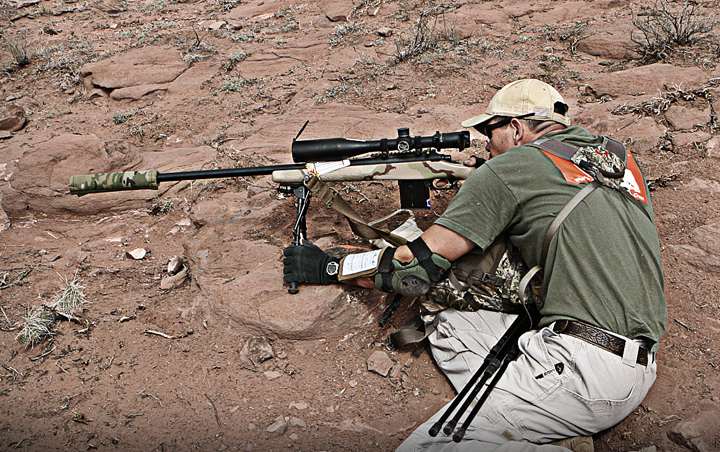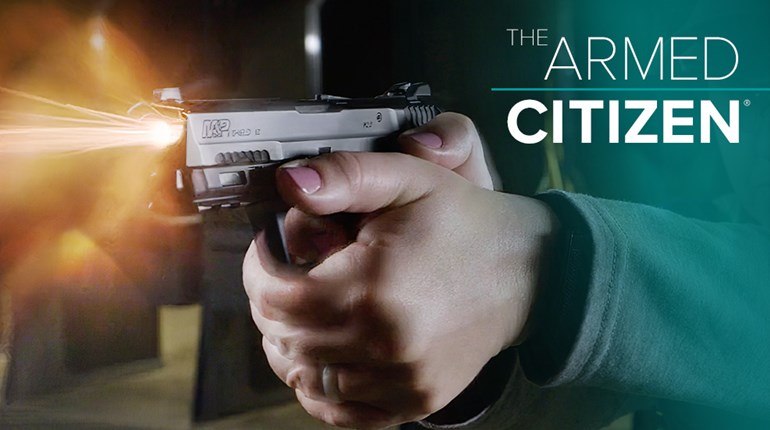
In the mid 1990s, retired LAPD officers David and Loraine Wheeler decided to move out of California. Their new home, Blue Steel Ranch, was situated in the high desert about 50 miles north of Tucumcari, N.M., near the small town of Logan. Dave had long enjoyed all kinds of competitive shooting, and a 1,000-plus-acre ranch makes for a great place to shoot rifles.
Shortly after getting settled in, the Wheelers’ birthed a new kind of match—the Steel Safari. For three days in early June each year, 40 to 50 shooters travel to Blue Steel Ranch to brave the elements and see how they stack up against some of the best rifle shooters in the world.
Stages go like this: You walk a marked course until you come to a marked hold point 30 to 50 yards from the shooting position. When given the signal, you approach the shooting position and get a short stage brief from the Range Officer, who tells you where you need to shoot from and your shooting boundaries. Once you shoot, you clean up your gear, take a drink and get ready to serve as Range Officer for the shooter behind you. As soon as they’ve shot, you head for the next stage.
The match is pretty simple, albeit not physically easy. You drag everything you will need for a 2- to 4-mile trek to shoot 60 targets in 110- to 115-degree heat and, quite often, ugly winds. If there are six targets at a station, you must be close enough to the firing point marker to touch it with either hand while shooting. If there are three targets, you shoot them from the first position, move to the second position marker and reengage them again, staying within arm’s reach of the marker. You have only five minutes to locate, range and engage the targets.
The only intel you get is having the area where the targets are located identified to you before time starts. You might be shooting off a cliff with your first target located 175 yards away, downhill at 45 degrees, or it might be 700 yards away across a valley. The far target at any given station might be 500 yards away, or it might be 1,000.
The steel targets themselves vary in shape and size. You could be shooting a 3-by-5-inch rectangle at 250 yards, or a 10-inch diamond at 800 yards. Sometimes there will be a morale-builder—a 10-inch round target at 450 yards.
Shooting positions vary. Many targets are shot off your belly in some sort of prone(ish) position. You need to shoot other targets using shooting sticks, or just man-up and shoot offhand or in some sort of supported standing position. You only get one shot per target. No make-up shots are allowed, so being rock solid and calling the wind right on your first shot are critical.
Gear & Preparation
I was shooting a 2009 Accuracy International AX chambered in 6 mm Competition Match, feeding it a 115- grain DTAC bullet on top of H-1000 powder in a Lapua case. The scope was a Schmidt & Bender 5-25x with a Gen2 XR reticle, a 3gunstuff lever held in place by a Spuhr mount. I attached a Thunder Beast 338 Brake Attach Suppressor. In my Kifaru pack, I carried about 75 rounds of ammo, Leica rangefinders, a wind meter, three spare magazines, 1.5 gallons of water, some candy for a sugar boost, a takedown cleaning rod and carbon fiber tripod. All that stuff weighed in at about 30 to 35 pounds. By the end of the 4-hour trek, most of the ammo and water was gone, making for a lighter pack.
About two months out from the match I start spending more time at the range with the rifle I intend to shoot. Instead of burning ammo at 8-inch plates from 300 to 400 yards, I try to shoot a lot of different sized/shaped targets at various distances. I have a few 3-by-5 inch targets I set up at 250 to 350 yards. Even on a good day that is no easy target. I also put a 10-inch plate at 500 yards, and another at 600 yards.
To make practice more like the match, I don’t shoot from a traditional prone position. I might shoot off a backpack, 55-gallon drum, picnic bench or shooting sticks. In my head, I build up a stage and shoot it like I would at Steel Safari.
I don’t always shoot the closest target first, but prefer to first shoot the easiest target as a check on my wind call. From there I dial my elevation knob to the next distance and take that shot. I also practice just holding over for all targets. If you get in a hurry, taking the time to dial a handful of clicks can slow you down. Being able to use correct holdover is another skill to have in your back pocket.
About three weeks out, I clean my rifle and give every part a once-over, mainly checking for wear or broken parts. I use locktite on all screws and bolts, but I still check them because you can’t be too careful. I also start loading match ammo.
I load my 6CM ammo on a Dillon 550, using a Prometheus Powder dispenser that is accurate to a single kernel of powder. That is simply another can’t-hurt/might-help kind of thing. I take a small batch of ammo to the range, along with a chronograph, to verify my clean bore zero and velocity. Different lots of powder can give different velocities. Out past 500 yards, 20 f.p.s. can mean the difference between a hit and a miss. Once the ammo and rifle check out, I load the remaining ammo.
In the few days before the match I lay out all my stuff on the floor of my basement. Everything that uses a battery gets a new one, optics lenses get cleaned, etc. I also start hydrating. Having to worry about staying hydrated during the match isn’t fun and can cause a lapse in concentration.
Following the 41/2-hour drive to the range and checking in, I shoot 10 to 15 rounds just to verify my zero. Seeking out old friends and catching up is next—and most important. Later that afternoon, we learn everything we need to know about navigating the match safely in a brief shooters meeting.
Day 1
I drew the south course, which is normally a good thing. It’s typically a morale builder, but this day it was not. Earlier in the week, eastern New Mexico had received lots of rain. This meant the dirt was still very wet and dark, and overcast skies made things appear even darker. The average target distance on the south course is closer due to the terrain, but the shooting positions are traditionally more technical. Stage One would be shot from the window frames of an old abandoned stone house, and I was able to hit five of six targets with little drama.
But on Stage Two, my wheels came off. I had a heck of a time locating the targets. The steel targets hang from a rebar sawhorse, and the target is attached by a chunk of black conveyer belt. I couldn’t even find the conveyer belt, so I chose to shoot what I could find. The pain of not being able to find targets would haunt me for the rest of the day, as I was barely able to score half of the available points.
One stage had us shooting from the side of a hill. With no way to get prone within arms reach of the marker, I ended up shooting off my pack for three shots, then moving forward to shoot from the top of a small boulder for the remaining three. Several times I used my tripod to get enough elevation to make a shot or two. Shooting off a tripod is hard enough, but trying to hit a small target several hundred yards away while the clock ticks away doesn’t help.
The high point of the day was my Range Officer, Dave Roberts. Dave is a honcho at U.S. Optics and one of the funniest guys I have ever shot with. He had a great attitude, and we worked well together.
Day 2
The north course traditionally has targets out past 800 to 900 yards and involves mostly prone shooting with an occasional incredibly awkward and ugly shooting position. Plus, the winds on the north course are often tricky. The wet dirt also meant two things—no dust blowing around, and minimal dust being kicked up if you missed. Often a miss will reveal exactly where you missed so you can make a correction for the next target, but not this day.
The sun was out this day, so finding targets was easier. Stage One started out with three targets and two positions out to 600 or so yards—two small diamonds and one large diamond. The first three shots were off my tripod and the second marker was on a dead tree, which I used for support. It was a tough stage, and I was very happy with four hits.
One of my favorite stages was another three-target stage. The first firing point was prone. Like most of the north course stages, you are on top of a plateau shooting down. The second firing point was 25 to 30 yards down over the ledge, shooting off another ledge. Here you could go prone, but you were twisted up into a 90-degree angle to make it work. The other seven stages were not as difficult in respect to shooting positions, but the target distances got further and the winds picked up into the afternoon.
Day 3
The west course was new for the Steel Safari. Normally the first day’s shooting is done on the known-distance range. This year, Competition Dynamics changed it up. They compressed the south and north courses and opened up the terrain in the middle for more challenges.
And it was challenging. The day started off with a 1.5- to 2-mile trek to the starting point. With 20 minute spacing between shooters, we rarely saw any other shooters but our range officer. This day’s stages were incredibly fun, with shooting positions ranging from simple to complicated. If you tried to overthink things, you could make it so difficult you’d run out of time. Most of the targets were between 300 and 600 yards, with only a couple out past 800 yards.
On one stage that had three targets from two positions, I was able to quickly find two of the targets. The third was hiding somewhere. Time was ticking away. Then I remembered to look close—as in 150 yards and downhill at a 45-degree angle. There it was, a medium-sized rectangle in the bottom of a ditch, partially obscured by a large tree. If you stood up, it was plain as day. But anything lower than standing and you couldn’t see it at all.
With time getting away, I blew off the option of any type of support and threw a Hail Mary shot. I got lucky and hit that target. I then dropped prone and shot the other targets. Now it was time to move and repeat it. I was hoping to have a clearer shot on the close-up target, so I would not have to rely on luck yet again. But again I had to shoot offhand. I left the stage grinning from ear to ear.
When I finally reached the last stage, a few people who had already finished shooting had gathered there to heckle me, cheer for me or a little of both. Hitting more than 85 percent of the targets for the day, I was able to dig myself out of the hole I had dug for myself earlier. Mentally, the whole day’s shooting was a win. I found all but one target, was able to get solid shooting positions and every miss was me missing a wind change.
Thanks to generous donations by many companies, the prize table featured lots of good stuff like a custom Surgeon bolt action rifle in 260, Thunder Beast suppressors, USO and Steiner scopes, and nearly everything else that a long-range field shooter could want or need. I ended up tied for 4th place.
John Griswold absolutely crushed the match with his trusty .243. He solidly won each of the three courses, giving lessons to all of us. At the 2012 Snipers Hide Cup he missed first place by a fraction of a point, so to see him win here was very cool.
All in all I had a great time. I got to hang out with good friends, tell war stories and get some shooting in. Competition Dynamics and Dave Wheeler made some great changes to the match format, giving us more shooting and more difficult challenges.
I know I will be back. But next year I hope they work on the humidity and rain.

